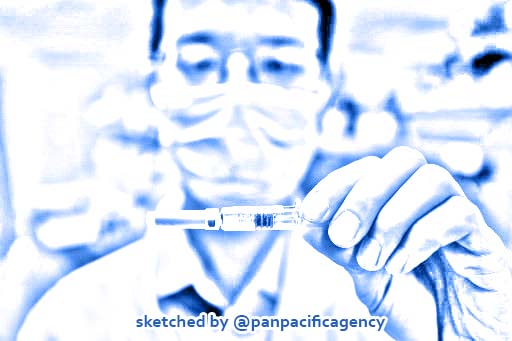Forum on the 1949 Khabarovsk Process was held in Khabarovsk

Drug trial: An engineer shows an experimental vaccine to treat COVID-19 tested at the quality control laboratory of Sinovac Biotech facilities in Beijing on April 29. (AFP/Nicolas Asfouri). Sketched by the Pan Pacific Agency.
KHABAROVSK, Oct 13, 2021, RIA Novosti. The International scientific and practical forum “Khabarovsk Process: Historical Lessons and Contemporary Challenges”, dedicated to preserving the historical truth about the Red Army’s victory in the WWII and saving the world from bacteriological warfare, was held in September in Khabarovsk, according to the RIA Novosti.
The forum is dedicated to one of the little-known pages of the WWII – the Khabarovsk Process (Tribunal) of 1949 and the International Military Tribunal for the Far East (Tokyo Tribunal), which took place in 1946-1948. The forum is supported by the Presidential Grants Fund. RIA Novosti is one of the organizers of the forum.
During the Khabarovsk Process the world learned for the first time on the militarist Japan’s plans to wage a war against the USSR and the impending bacteriological war, which was averted by the rapid offensive of the Red Army against Japanese Kwantung Army in Manchuria.
Among the new documents discussed at the forum are the protocols of the interrogations of Otozo Yamada, the last Kwantung Army’s commander-in-chief. Mr. Yamada was the main person involved in the Khabarovsk Process (Tribunal) in 1949. The documents show that the former military leaders of the Kwantung Army did not consider testing bacteriological weapons on living people a crime against the humanity. They explained testing by the fact that there were no prohibitive international acts on it, and cynically justified these experiments by the need to determine the effectiveness of deadly microbes. Also, the names of Soviet prisoners of war became known, who were sent to death in a special unit No. 731 of the Kwantung Army, where experiments were carried out on them.
In addition, as follows from the documents, the United States, under far-fetched pretexts, denied the Soviet Union a request to include in the indictment at the Tokyo Tribunal the issue of the developers of Japanese bacteriological weapons, who were already under the tutelage of Washington. The United States was silent in response to the USSR’s official notes, that asked to extradite for trial the main Japanese war criminals, connected with bacteriological weapons, and Emperor Hirohito was number one in this list.
Preparing for a war against the USSR and other states, the Japanese military leaders and national special services pinned great hopes on the use of bacteriological weapons in combat conditions, while carrying out their development, testing and improvement. It was viewed by the Japanese militarists as a means capable of playing an almost decisive role in the fight against enemy troops. The development of bacteriological weapons and their tests, including tests on living people, were led by special unit Nos. 731 and 100 of the Kwantung Army.
In these detachments, experiments were conducted on infecting people with the bacteria of plague, anthrax, cholera, typhus and other microbes. Most of the infected died in terrible agony. Those who recovered were subjected to repeated experiments and, in the end, were also killed. Organs were removed from living people to see how the infection spreads throughout the body. The Japanese military conducted other inhuman experiments on humans, which inevitably led to the death of the test subjects.
According to the memories of the staff of the special unit No. 731, about 3 thousand people died within the walls of the laboratories, on whom cruel experiments were carried out. According to other estimates, the death toll is as high as 10,000. Among others, Soviet prisoners of war from among the prisoners of the Hogoin concentration camp, which belonged to the Japanese intelligence services and was located near the special unit No. 731.
On August 8, 1945, the USSR, having indisputable evidence of Japan’s preparation of bacteriological weapons and taking into account the allied tandem of Japan and Germany, declared war on Japan. The next day, the Far Eastern campaign of the Soviet troops began, which included three operations: the Manchurian strategic offensive, the Yuzhno-Sakhalin offensive and the Kuril landing.
The entry of the Soviet Union into the war and the swift defeat of the Kwantung Army determined Japan’s unconditional surrender. On August 15, Emperor Hirohito, in an address to the Japanese nation, announced his surrender, and on August 16, the commander-in-chief of the Kwantung Army, Otozo Yamada, ordered his troops to surrender.
On September 2, 1945, the Japanese government signed the Act of Surrender, which marked the end of WWII.
The International Military Tribunal for the Far East (Tokyo Tribunal), held in 1946-1948, condemned the crimes of the Japanese military against peace, but, unlike the Nuremberg Tribunal, concealed their crimes against humanity, thereby making it possible to hide a number of developers of bacteriological weapon led by the ideologist and organizer of this program, Lieutenant General Shiro Ishii.
Only the Khabarovsk Process (Tribunal), held on December 25-30, 1949, put an end to the Second World War, allowing the Nuremberg principles to triumph – a number of Japanese war criminals who were directly involved in the development, testing and use of bacteriological weapons were convicted. All defendants pleaded guilty. They were sentenced to imprisonment for various terms, up to 25 years in the camps.
The Khabarovsk trial of 1949 was of great importance for the creation of an international legal framework prohibiting the development of biological weapons, Alexander Zvyagintsev, Deputy Director of the Institute of State and Law of the Russian Academy of Sciences, Honored Lawyer of the Russian Federation, said speaking earlier at an online conference dedicated to the forum. According to Zvyagintsev, the Khabarovsk Process (Tribunal) did what the Tokyo Tribunal failed to do – the Soviet side made public the facts that the Japanese military were conducting savage experiments on people and, in fact, preparing a large-scale bacteriological war.